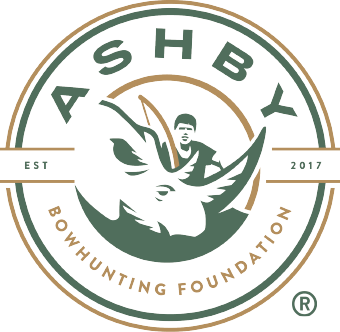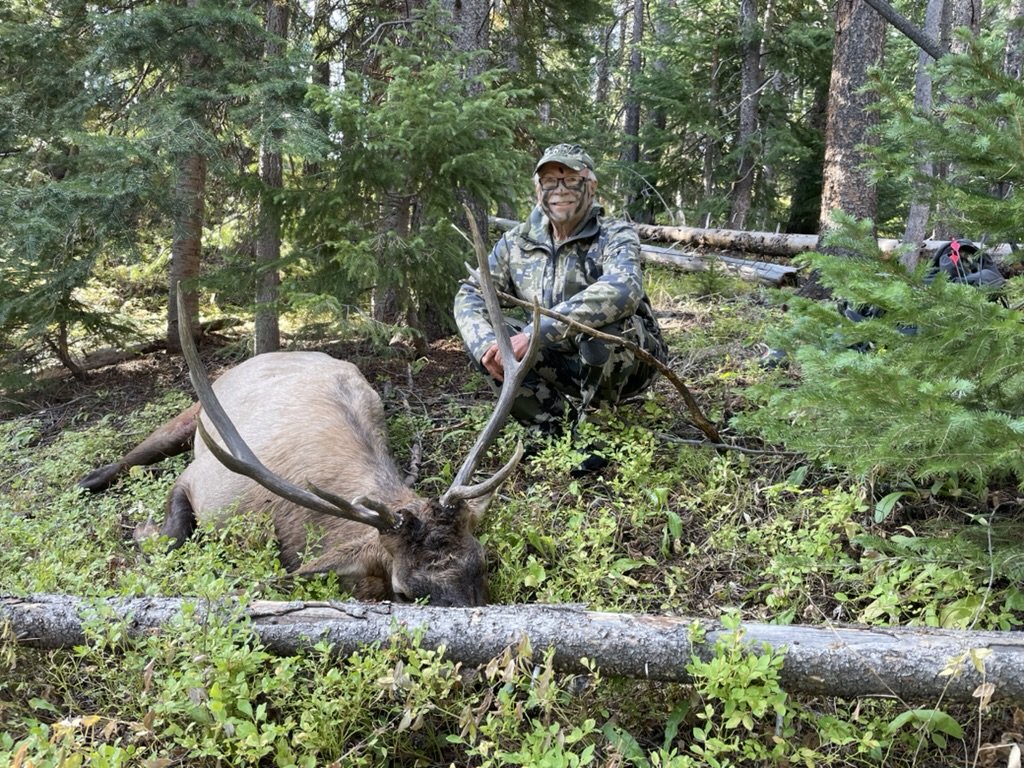Bowhunter Interview - Dennis Wehling
Drawing of Dennis hunting pronghorn. Shari Fraker, artist.
1. How long have you been a bowhunter?
I started when I was about eight or nine years old which would have been in about 1959. My dad bought me my first bow at a rural “Five and Dime” in central Utah for $2.50. Bowhunting has been a lifelong journey that I am still able to enjoy well into my seventies.
2. Do you hunt with traditional equipment, compound, crossbow, or a combination of these?
I have hunted with, long bows, recurves and compounds. I saw my first compound bow in about 1969 when a neighbor happened to show me his new bow. I primarily hunt with compound bows these days.
3. What is/are your favorite animal(s) to hunt?
Dennis: I have been blessed to hunt most all western big game species; however, I would say my favorite animal to archery hunt has to be elk followed by antelope, deer and turkeys.
4. What is/are your favorite bowhunting method(s): stands, still hunting, spot and stalk, pure stalking, or other?
As I have grown older, I would say my favorite methods are calling and hunting small water sources or travel routes for elk. In my earlier days I primarily still hunted elk and or spot and stalk when the opportunity would arise. I am open to hunting whatever method would seem to provide my best chance of success while still maintaining a fair and ethical standard to the animal. I love to bow hunt spring turkeys and spot, and stalk fall turkeys while elk hunting. I also enjoyhunting antelope with my homemade antelope decoy.
Dennis in his large archery/bowhunting shop. You can see the paper tuning target off his right shoulder.
5. What event(s) brought you to use Ashby-style arrow setups?
Lack of consistent results is what brought me to the Ashby Studies. Early in my bowhunting career I was blessed with much success, and it seemed that if I hit an animal, recovery was 100%. This early success led to forming a six-day bowhunting school here in Colorado with a fellow bowhunter. Our instructors were some of the who’s, who of Colorado bowhunting. At that time in the early 1980’s it seemed almost all bowhunters were shooting a standard set up ofabout 600 grains. Our school focused on shooting fundamentals, shot placement, scouting and all general outdoor skills. It was about then I first heard about the Dr. Ed Ashby Studies which always seemed to be followed by the statement it was for traditional archers, and it didn’t apply to compound bowhunting. Big mistake on my part was not doing my own research and I owe Ed an apology. At the same time there was a push to lighten our arrows to allow flatter trajectory since yardage was a guess based on feel, before rangefinders.
Arrows used throughout my hunting career, prior to finding the Ashby system.
Here is a photo of a few arrows primarily from animals showing what lead to my Ashby journey, which was poor penetration, broadhead failures and decreasing harvest rates. Arrows on the far right were my old 625 + or - grain arrows with long skinny 125 grain four blade Satellite broadheads. As I recall I had 100% recovery rate with that setup. Next, I thought a wider broadhead would increase blood trails, so I tried Rocky Mtn Supreme heads which were heavier (150 grains) and wider (1 -1/2”) and success started to drop. Soon, speed started to be a thing so I thought a faster arrow would help. So, I dropped to a lighter shaft (2215’s) but stayed with Rocky Mtn Supreme heads for a while. Next, I tried Zwickey Delta, Eskimo and Magnus broadheads, because they were supposed to penetrate better. Blades were only file sharp which was the thing back then. I started seeing more flight issues and sometimes I broke the welds and or bent the tips however I was lucky a few times. As carbon shafts came on the Market, I started trying lighter carbon shafts, but then I started to see deflections, broken shafts usually right behind the inserts. I stopped saving carbon shafts so only a few are in the pile. I then tried an Ulmer mechanical head one year, then Ramcats, followed by Muzzy four blade and lastly standard Slick Trick four blade. At first, I thought the failures were just me being unlucky, which was true sometimes, however I was seeing a lot of deflections, but then I would get a pass through that might miss ribs on both sides. Basically, I had gone from 625 grains to 550 grains, to just under 400 grains then back to about 425 grains and nothing was getting better which started me on the journey to find something better which led to the Ranch Fairy and the Ashby Bowhunting Foundation.
Bull elk taken with the Ashby system, a 50 yard recovery.
Next was the theory that increasing broadhead size would increase internal damage and improve blood trails. This all seemed to make some sense; however, I noticed my penetration and harvest rate was declining. Thinking these failures were all my fault I started to question every shot opportunity and was soon passing up easy shots for fear of failure. I began reflecting on past success and became convinced that I needed to recreate my old system with modern components, but I still didn’t really know why it had worked so well. I was struggling to find what I wanted when I stumbled upon the “Ranch Fairy” YouTube channel. Troy’s experience was much like mine with failures we hadn’t seen back in the old days. Following Troy’s advice I purchased “Ranch Fairy” test kit and decided to give it a try. That first year I shot a 625-grain arrow with 200-grain single bevel broadhead just to give it a try. That year my wife was wanting to go see some Colorado fall colors and tag along on a short elk hunt. On the first morning I was cold calling when a bull suddenly appeared. As he walked by at 8 yards, I shot him quartering in and was shocked at the bull’s reaction and my arrows complete penetration out the rear quarter into the ground. The bull jumped then just walked away to about 50 yards and stood until he fell over. It was at that moment that I was hooked on the Ashby system. I have never seen penetration like that nor such a short distance for recovery. The following year I increased my arrow weight to 709 grains and took a great bull at 45 yards quartering away again with complete penetration and the arrow stuck in the ground. The bull jumped at the shot only walking about 50 yards before falling over. Finding Troy and the Ashby studies has brought back my joy of bowhunting and given me the confidence to start shooting again. Seeing these results has been what I have spent a lifetime searching for. I want to thank Troy Fowler, Rob Neilson and Jeremy Johnson all for helping me along the way and Dr Ed Ashby for his lifetime of work to make us all more lethal and ethical bowhunters.
Check out Dr. Ed Ashby’s 12 Penetration Factors!
Victory RIP TKO 250 spine, 65 grain Titanium post and collar, 300 grain Tuffhead North American 3:1, four fletch feathers cut A&A style at 2.5”. Total arrow weight 655 grains and 28% FOC
6. Could you describe your typical arrow setup(s) for hunting big game?
Dennis: My typical arrow setup is for elk which is my largest target animal is somewhere between 650 and 710 grains. These are all 12-factor arrows minus tapered shaft. I am shooting 250-spine shafts with 3:1 Tuffheads and four fletch feathers as my standard setup currently. Typically, every year I work to improve my arrow setup as additional Ashby and or Ranch Fairy testing shows areas I could improve on.
7. Overall, what has been your experience using Ashby-style arrow setups?
I would say my Ashby style setups have been like magic on elk. So far, my harvest rate has been 100% on elk which is much improved over any of my lighter setups. The first thing I noticed was all my shots have been pass-throughs on elk and lesser game. At the shot the elk jumped but don’t seem to realize what happened. It’s almost like they think a bird is what scared them. Following the jump, they seem to run a few yards then walk away slowly a short distance. So far, they have all stopped within about 50 yards and stood until they fell over. It seems my Ashby setup are much less stressful on the animals and the recoveries have been within sight which is a blessing.
8. Do you have any bowhunting tips you would like to pass along?
Dennis and his son Derek at the Colorado Bowhunters Association Jamboree.
Over the years I have learned many lessons that I would like to share. The first one is the theory that fast long-range shooting is somehow the secret to bowhunter success. One of the popular websites has what they call a cold bow challenge, which is a test of bowhunters maximum effective range over three days. Hunters cannot practice once they start the challenge and can only shoot one arrow with a broadhead each day over three or more days, but only three total shots with no practice in-between. It is a great reflection of what bowhunters think is their maximum range and the reality of their actual ability. One hunter said his maximum range was about 50 yards but wondered how to score his shot when his expandable head bounced out of his foam target even though a small screw held the blades closed. The sad thing was most guys thought he should just be able to shoot an extra shot because that one didn’t count. It is a sad state of the current light and fast crowd not concerned about penetration and only consider score/hit as success. The challenge is great practice, but hitting the kill zone with an ineffective arrow system isn’t ethical when applied to actual bowhunting.
I would like to share the importance of mentors for new hunters and the importance of learning hunting skills on live animals. Experience is the best teacher. I started down the Ashby setup late in life and now look back and realize I could have doubled my harvest rate by simply following and adopting the Ashby study and the 12 penetration factors many years ago.






